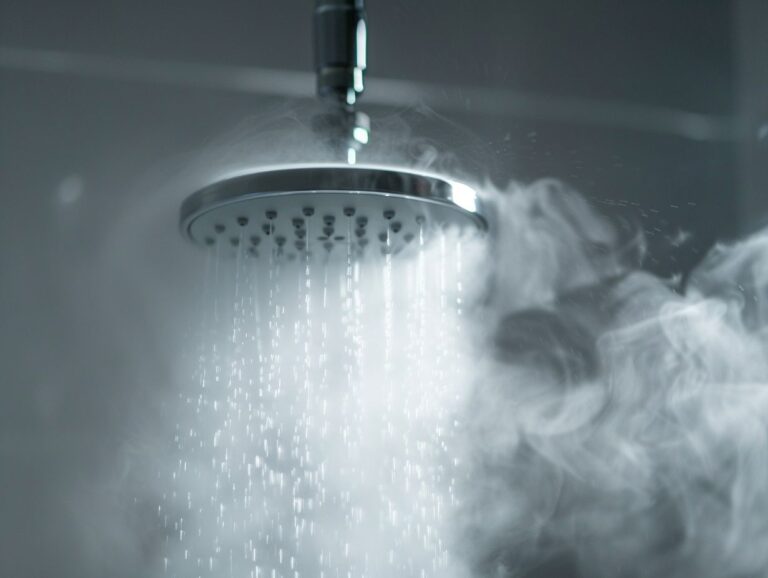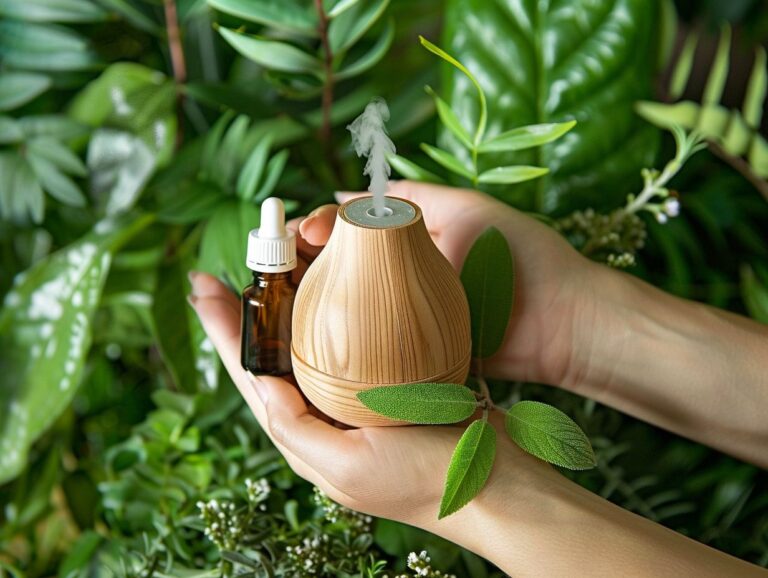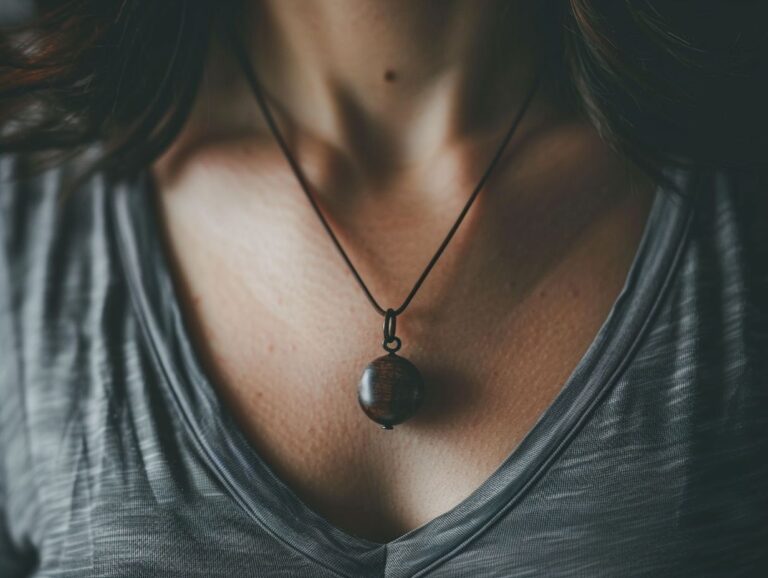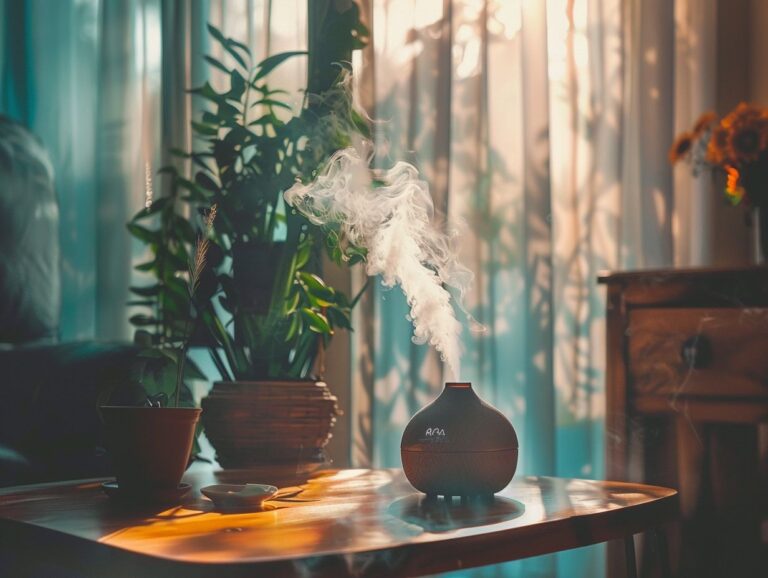What Are the Physical Benefits of Aromatherapy
Are you curious about the physical benefits of aromatherapy?
From reducing pain and inflammation to improving skin health, aromatherapy offers a wide range of advantages for your well-being.
Explore how aromatherapy works and its various physical benefits, including boosting the immune system, enhancing digestion, and balancing hormones.
Learn about the different types of aromatherapy and how you can easily incorporate it into your daily routine at home.
Discover the wonders of aromatherapy today!
Key Takeaways:
What Is Aromatherapy?
Aromatherapy is a holistic healing treatment that uses natural plant extracts, known as essential oils, to promote health and well-being. It is based on the principle that specific aromas can have psychological and physiological effects on the body.
Originating from ancient civilizations like Egypt, China, and India, aromatherapy has been used for centuries as a therapeutic practice. The National Association for Holistic Aromatherapy (NAHA) defines it as the art and science of utilizing naturally extracted aromatic essences from plants to balance, harmonize, and promote the health of body, mind, and spirit.
Essential oils, derived through processes like distillation or cold pressing, are the core of aromatherapy. These potent extracts capture the plant’s fragrance and therapeutic properties, offering a natural and non-invasive way to support overall wellness.
How Does Aromatherapy Work?
Aromatherapy works by stimulating the smell receptors in the nose, which then send messages to the limbic system in the brain, responsible for emotions and memory. The essential oils used in aromatherapy can impact various physiological functions through their aromatic compounds.
These aromatic compounds are inhaled or absorbed through the skin during aromatherapy sessions. Once in the body, they can trigger chemical responses that influence heart rate, stress levels, blood pressure, and even immune function. The limbic system’s connection to these aromatic compounds is crucial for their therapeutic effects, as it helps regulate mood, stress, and overall well-being. By targeting the brain through smell receptors, essential oils have the power to promote relaxation, improve focus, and alleviate symptoms of anxiety and depression.
What Are the Physical Benefits of Aromatherapy?
Aromatherapy offers a range of physical benefits, including reducing pain and inflammation, improving sleep quality, boosting the immune system, and enhancing skin health. Essential oils like lavender oil have been studied for their positive effects on various physiological functions.
Research has shown that inhaling lavender oil can help reduce the perception of pain through its calming and analgesic properties. The anti-inflammatory characteristics of lavender oil make it beneficial for alleviating conditions like muscle soreness and joint pain.
Studies have also indicated that lavender oil can have a positive impact on the immune system, enhancing its ability to fight off infections and illnesses. This immune-boosting effect is attributed to the antimicrobial properties of lavender oil that help combat pathogens.
The use of lavender oil in aromatherapy has been linked to improved skin health by promoting cell regeneration, reducing acne, and soothing skin irritations. Its antioxidant properties can help protect the skin from damage caused by environmental factors.
Reduces Pain and Inflammation
Aromatherapy has been found to be effective in reducing pain and inflammation through the use of essential oils like cypress oil and sweet marjoram oil. Research suggests that these oils can provide natural relief for various conditions.
Cypress oil has demonstrated analgesic properties, helping to alleviate muscle cramps and joint pains. Sweet marjoram oil, on the other hand, is known for its anti-inflammatory effects, making it beneficial for reducing swelling and inflammation in the body. These natural remedies not only offer relief from physical discomfort but also promote relaxation and a sense of well-being.
Improves Sleep Quality
Aromatherapy is known to improve sleep quality by promoting relaxation and reducing anxiety, with essential oils like lavender playing a key role in inducing a restful state. Research has shown positive effects on sleep patterns and overall well-being.
In terms of enhancing sleep, lavender essential oil has been widely studied for its calming effects on the nervous system, helping to reduce stress and quiet the mind before bedtime. Psychological benefits of using lavender oil include lowering heart rate and blood pressure, which can contribute to a deeper and more restorative sleep. The soothing aroma of lavender is believed to trigger the release of neurotransmitters that promote relaxation, making it an ideal choice for those struggling with insomnia or disrupted sleep.
Boosts Immune System
Aromatherapy has been shown to boost the immune system by enhancing the production and activity of key immune cells, such as red blood cells, white blood cells, and lymphocytes. Research indicates that certain essential oils can modulate immune function by influencing specific cell types.
For instance, studies have revealed that the inhalation of lavender oil can reduce levels of interleukin-6, a pro-inflammatory cytokine, thereby promoting a more balanced immune response. Oils like tea tree and eucalyptus have antimicrobial properties that can help ward off infections. These essential oils work synergistically to support the body’s defense mechanisms, aiding in overall health and well-being.
Relieves Respiratory Issues

When these essential oils are inhaled, their properties can help reduce inflammation in the airways, allowing for easier breathing. Eucalyptus oil, for example, is well-known for its ability to act as a natural decongestant and can help clear blocked sinuses.
The steam from hot water infused with a few drops of eucalyptus oil can provide instant relief by opening up the airways and easing congestion. Peppermint oil, with its cooling sensation, can also provide a refreshing effect on the respiratory system.
Enhances Digestion
Aromatherapy has holistic benefits for digestion by using essential oils to promote gastrointestinal health and support digestive functions. Some oils, such as peppermint or ginger, can aid in soothing digestive discomfort and improving overall gut health.
Peppermint oil is often lauded for its ability to calm digestive issues like indigestion, bloating, and gas due to its soothing properties. It can also help reduce muscle spasms in the gut, providing relief for those with irritable bowel syndrome (IBS).
Ginger essential oil is known for its anti-inflammatory and carminative effects, making it effective in alleviating nausea, stomach upset, and promoting healthy digestion.
When used in aromatherapy, these oils can stimulate the release of digestive enzymes, improve nutrient absorption, and enhance overall digestion. The use of essential oils in holistic healing approaches not only addresses physical symptoms but also considers the connection between emotional well-being and gastrointestinal health.
Balances Hormones
Aromatherapy is known to help balance hormones through the use of essential oils that can influence endocrine functions. Oils like clary sage or geranium are believed to have hormone-regulating properties that support emotional and physical well-being.
Clary sage oil, for instance, is often praised for its ability to mimic estrogen in the body, making it beneficial for alleviating menopausal symptoms and promoting overall hormonal harmony. On the other hand, geranium oil is recognized for its balancing effect on adrenal glands, aiding in the regulation of cortisol levels and reducing stress.
When these essential oils are inhaled or applied topically, they can interact with the limbic system in the brain, which plays a crucial role in regulating emotions and hormonal responses. This connection between scent and brain activity is what contributes to the positive impact of aromatherapy on hormonal balance and emotional well-being.
Improves Skin Health
Aromatherapy offers benefits for skin health by utilizing essential oils that have therapeutic properties for various skin conditions. Oils like tea tree or rosehip can be used in skincare routines to address concerns such as acne, aging, or inflammation.
Tea tree oil is renowned for its antibacterial and anti-inflammatory properties, making it an effective natural remedy for acne-prone skin. Its ability to reduce redness and swelling while combating bacteria can help to clear up blemishes and prevent future breakouts.
On the other hand, rosehip oil is a nutrient-rich oil that is packed with antioxidants, vitamins, and essential fatty acids, promoting skin regeneration and improving skin texture.
When incorporated into a skincare regimen, these essential oils can work wonders for improving the overall health and appearance of the skin. Whether dealing with problematic skin conditions like acne or seeking anti-aging benefits, the therapeutic properties of tea tree and rosehip oils make them valuable allies in skincare treatments.
Reduces Headaches and Migraines
Aromatherapy can help alleviate headaches and migraines through the application of essential oils with analgesic and calming properties. Oils like peppermint or lavender are commonly used to reduce headache intensity and frequency.
Peppermint oil, in particular, is highly regarded for its ability to ease headaches due to its menthol content, which acts as a natural pain reliever. When applied topically or inhaled through a diffuser, its soothing aroma can help relax tense muscles and promote better circulation.
Lavender oil, on the other hand, is known for its calming effects, which can help reduce stress and anxiety levels that often contribute to headaches. Its anti-inflammatory properties also make it effective in alleviating headache symptoms.
Alleviates Menstrual Cramps
Aromatherapy has been found to alleviate menstrual cramps through the use of essential oils like lavender and sweet marjoram, known for their muscle-relaxing and pain-relieving properties. These oils can provide natural relief during menstrual discomfort.
When used in aromatherapy, lavender oil is particularly effective in calming the mind and body, reducing stress levels that can exacerbate menstrual cramps. Its soothing aroma can help ease muscle tension and promote relaxation, making it a popular choice for alleviating period pains.
Sweet marjoram oil is known for its analgesic properties, which can help alleviate pain and discomfort associated with menstrual cramps.
The combination of these two essential oils creates a potent blend that not only targets physical discomfort but also aids in emotional wellbeing during menstruation. Lavender oil promotes a sense of calmness, while sweet marjoram oil helps in relieving muscle spasms, ultimately providing a holistic approach to managing menstrual cramps. Incorporating these oils in a diffuser or massage oil can enhance the overall benefits and provide much-needed relief during this time of the month.
What Are the Different Types of Aromatherapy?
Aromatherapy encompasses various types of applications, including inhalation, topical application, aerial diffusion, and direct inhalation. Each method offers distinct benefits and can be tailored to individual preferences and needs.
Aerial diffusion involves dispersing essential oils into the air using a diffuser, allowing their aromatic scent to permeate the atmosphere. This method is especially beneficial for creating a relaxing or invigorating ambiance in a room, depending on the oils used.
On the other hand, direct inhalation involves breathing in the oils directly from a bottle or a tissue, offering quick relief for issues like congestion or stress.
Personalized approaches to aromatherapy involve custom blends of oils tailored to specific concerns, preferences, or desired effects, ensuring a more targeted and effective experience.
Inhalation

When inhaling essential oils, the molecules travel through the nasal passages to the olfactory system, stimulating the brain’s limbic system responsible for emotions and memories. This direct pathway can evoke feelings of relaxation, stress relief, or invigoration, depending on the properties of the oil.
The respiratory benefits of inhaling essential oils include clearing congestion, supporting respiratory functions, and promoting overall lung health. The act of mindful inhalation can promote a sense of mindfulness and mental clarity, enhancing one’s overall well-being.
Topical Application
Topical application involves directly applying essential oils to the skin for localized effects and absorption.
This method is known for its precise and targeted approach, allowing the essential oils to penetrate the skin and reach deep into the tissues, where they can work their magic. The skin, being the body’s largest organ, readily absorbs the oils, facilitating their entry into the bloodstream for quicker therapeutic benefits.
In terms of skincare, essential oils are often used to address various skin conditions such as acne, eczema, and dryness. For pain management, oils like peppermint and lavender can be massaged onto sore muscles for relief by reducing inflammation and promoting relaxation.
Aerial Diffusion
Aerial diffusion involves dispersing essential oils into the air using diffusers to create a pleasant and therapeutic room ambiance. This method can enhance mood, reduce stress, and purify the air.
Through the process of aerial diffusion, essential oils are broken down into tiny particles and dispersed into the air, allowing their aromatic properties to spread throughout the room. This dispersion not only adds a delightful fragrance but also carries the therapeutic benefits of the oils.
Diffusing essential oils can help create a calming atmosphere, perfect for unwinding after a long day, or setting a peaceful tone for relaxation and meditation. The aromatic molecules released interact with the senses, triggering responses in the brain that promote feelings of tranquility and well-being.
Direct Inhalation
Direct inhalation involves inhaling essential oils from portable inhalers or bottles for immediate benefits. This method is convenient for on-the-go use and can provide quick relief for various conditions.
Portable inhalers have become popular tools for utilizing direct inhalation in aromatherapy. These compact devices allow individuals to easily carry their favorite essential oils and inhale them whenever needed. Whether you prefer a nasal inhaler or a personal diffuser, these devices are designed for quick and easy use, making them ideal for busy lifestyles. Direct inhalation is ideal for targeting specific concerns such as stress relief, respiratory support, or mood enhancement.
How Can You Use Aromatherapy at Home?
Aromatherapy can be easily incorporated into your daily routine at home through various methods such as using essential oil diffusers, practicing steam inhalation, or enjoying the benefits of aromatherapy massage. These simple techniques allow you to experience the therapeutic effects of essential oils.
One practical way to introduce aromatherapy into your living space is by utilizing essential oil diffusers. These devices disperse the aroma of essential oils into the air, creating a soothing and calming environment.
Steam inhalation is a popular method that can be easily done at home by adding a few drops of essential oil to a bowl of hot water and breathing in the steam.
For a more immersive experience, consider incorporating aromatherapy into your self-care routine with massage. By diluting essential oils with a carrier oil and applying them during a massage, you can relax both body and mind, promoting overall well-being.
Essential Oil Diffusers
Essential oil diffusers are popular devices used to disperse aromatic essential oils into the air, creating a soothing and fragrant atmosphere in your home environment. These diffusers come in various types, such as ultrasonic, nebulizing, or heat-based diffusers.
Ultrasonic diffusers use water and ultrasonic waves to disperse the oils in a fine mist that not only scents the air but also adds moisture, making them ideal for dry climates.
Nebulizing diffusers use pressurized air to break down the oils into tiny particles, providing a more concentrated aroma without altering the oil’s properties.
Heat-based diffusers, meanwhile, use heat to evaporate the oils quickly, though they may not be as effective for larger spaces.
Topical Application
Topical application of essential oils involves diluting them with carrier oils and applying the mixture to the skin for specific benefits, such as hydration, relaxation, or pain relief. This method allows for targeted absorption and localized effects.
A key aspect of topical application in aromatherapy is the importance of proper dilution to ensure both effectiveness and safety. Dilution ratios can vary based on the essential oil used and the individual’s skin sensitivity. Applying essential oils directly to the skin without dilution can lead to skin irritation or sensitization. By blending essential oils with carrier oils like jojoba or coconut oil, the potency of the essential oils is maintained while reducing the risk of adverse reactions.
Steam Inhalation

Steam inhalation with essential oils is a beneficial practice for respiratory support and sinus relief. Adding a few drops of essential oil to hot water and inhaling the steam can help clear nasal passages, ease congestion, and promote respiratory comfort.
This technique, rooted in the ancient practice of aromatherapy, harnesses the power of aromatic compounds found in essential oils. When the steam is inhaled, these molecules travel into the respiratory system, exerting their therapeutic effects.
Eucalyptus oil, known for its decongestant properties, is a popular choice for steam inhalation. It acts as a natural expectorant, helping to expel mucus and open up the airways.
Aromatherapy Massage
Aromatherapy massage combines the benefits of touch therapy with the aromatic properties of essential oils to promote relaxation, reduce stress, and alleviate muscle tension. This therapeutic massage technique helps enhance overall well-being and emotional balance.
During an aromatherapy massage, the skilled therapist uses a combination of gentle strokes, kneading, and acupressure techniques to relax the body and release tension. The application of essential oils, such as lavender for calming effects or peppermint for invigoration, adds an extra dimension to the massage experience. The scents of the oils not only stimulate the olfactory senses but also work on a deeper level to soothe the mind and promote a sense of well-being.
Frequently Asked Questions
What are the physical benefits of aromatherapy?
Aromatherapy has been known to provide numerous physical benefits, some of which include:
How does aromatherapy improve respiratory health?
Certain essential oils used in aromatherapy, such as eucalyptus and peppermint, have been found to have anti-inflammatory and antimicrobial properties, helping to improve respiratory health.
Can aromatherapy help with pain relief?
Yes, certain essential oils like lavender and chamomile have analgesic properties that can help reduce pain and inflammation when used in aromatherapy.
What effects does aromatherapy have on the immune system?
Aromatherapy has been found to have immune-boosting effects, as certain essential oils can stimulate the production of white blood cells and help fight off infections and illnesses.
How does aromatherapy benefit the skin?
Aromatherapy can benefit the skin in several ways, including reducing inflammation, improving circulation, and promoting cell regeneration. Essential oils like tea tree and lavender are commonly used for skin health.
Can aromatherapy help with stress and anxiety?
Yes, aromatherapy has been found to have calming effects on the mind and body, helping to reduce stress and anxiety. Essential oils like bergamot and ylang-ylang can promote relaxation and improve mood when used in aromatherapy.







